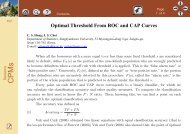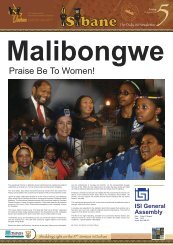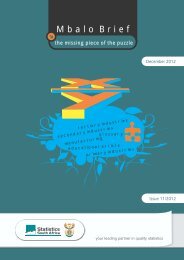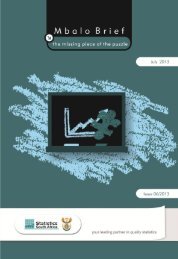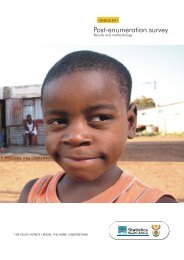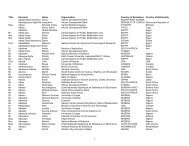General household survey - Statistics South Africa
General household survey - Statistics South Africa
General household survey - Statistics South Africa
Create successful ePaper yourself
Turn your PDF publications into a flip-book with our unique Google optimized e-Paper software.
<strong>Statistics</strong> <strong>South</strong> <strong>Africa</strong> 50<br />
P0318<br />
• If the filter question had a missing value, the filter is allocated the value that corresponds with the<br />
subsequent question which had a valid value.<br />
• If the values of the filter question and subsequent question are inconsistent, the filter question’s<br />
value is set to missing and imputed using either the hot-deck or nearest neighbour imputation<br />
techniques. The imputed value is then once again tested against the skip rule. If the skip rule<br />
remains violated the question subsequent to the filter question is dealt with by either setting it to<br />
missing and imputing or if that fails printing a message of edit failure for further investigation,<br />
decision-making and manual editing.<br />
In cases where skip violations take place for questions where multiple questions follow the filter question,<br />
the rules used are as follows:<br />
• If the filter question has a missing value, the filter is allocated the value that corresponds with the<br />
value expected given the completion of the remainder of the question set.<br />
• If the filter question and the values of subsequent questions values were inconsistent, a counter is<br />
set to see what proportion of the subsequent questions have been completed. If more than 50% of<br />
the subsequent questions have been completed the filter question’s value is modified to<br />
correspond with the fact that the rest of the questions in the set were completed. If less than 50%<br />
of the subsequent questions in the set were completed, the value of the filter question is set to<br />
missing and imputed using either the hot-deck or nearest neighbour imputation techniques. The<br />
imputed value is then once again tested against the skip rule. If the skip rule remains violated the<br />
questions in the set that follows the filter question are set to missing.<br />
When dealing with internal inconsistencies as much as possible was done using logical imputation, i.e.<br />
information from other questions is compared with the inconsistent information. If other evidence is found to<br />
back up either of the two inconsistent viewpoints, the inconsistency is resolved accordingly. If the internal<br />
consistency remains, the question subsequent to the filter question is dealt with by either setting it to<br />
missing and imputing its value or printing a message of edit failure for further investigation, decisionmaking<br />
and manual editing.<br />
Two imputation techniques were used for imputing missing values: hot deck and nearest neighbour. In both<br />
cases already published code was used for imputation. The variable composition of hot decks is based on<br />
a combination of the variables used for the Census (where appropriate), an analysis of odds ratios and<br />
logistic regression models. <strong>General</strong>ly, as in the QLFS system, the GHS adds geographic variables such as<br />
province, geography type, metro/non-metro, population group, etc. to further refine the decks. This was not<br />
done for Census 2001 and it is assumed that the reason for this is the differences in deck size and position<br />
for sample <strong>survey</strong>s as opposed to a multi-million record database.<br />
The ‘No’ imputations assume that if the ‘Yes’/’No’ question had to be completed and there is a missing<br />
value next to any of the options the response should have been ‘No’. Missing values are therefore<br />
converted to the code for ‘No’, namely ‘2’. This is only done if there is some evidence that the questions<br />
have been completed. Otherwise all remain missing. For questions for which each option represents a<br />
question, no ‘No’ imputations were made.<br />
18.12 Definitions of terms<br />
A <strong>household</strong> is a group of persons who live together and provide themselves jointly with food and/or other<br />
essentials for living, or a single person who lives alone.<br />
Note: The persons basically occupy a common dwelling unit (or part of it) for at least four nights in a week<br />
on average during the past four weeks prior to the <strong>survey</strong> interview, sharing resources as a unit. Other<br />
explanatory phrases can be 'eating from the same pot' and 'cook and eat together'.<br />
Persons who occupy the same dwelling unit but do not share food or other essentials, are regarded as<br />
separate <strong>household</strong>s. For example, people who share a dwelling unit, but buy food separately, and<br />
generally provide for themselves separately, are regarded as separate <strong>household</strong>s within the same<br />
dwelling unit.<br />
Conversely, a <strong>household</strong> may occupy more than one structure. If persons on a plot, stand or yard eat<br />
together, but sleep in separate structures (e.g. a room at the back of the house for single young male<br />
members of a family), all these persons should be regarded as one <strong>household</strong>.<br />
Multiple <strong>household</strong>s occur when two or more <strong>household</strong>s live in the same dwelling unit.<br />
<strong>General</strong> Household Survey, July 2011



